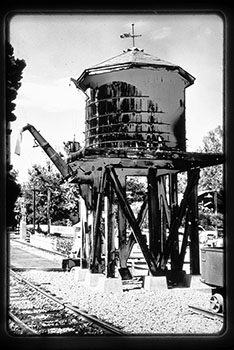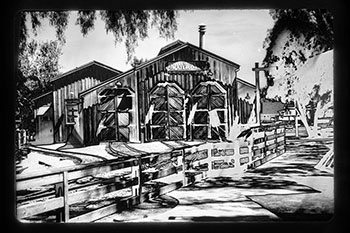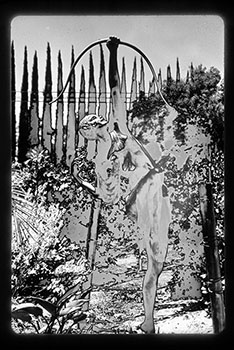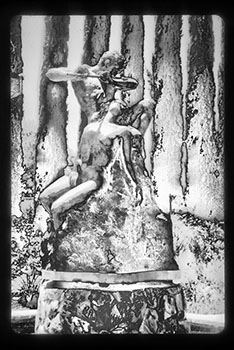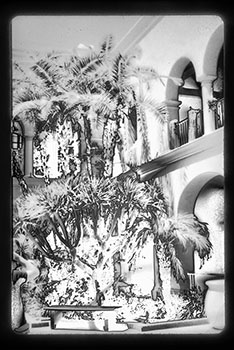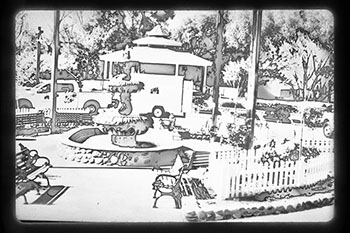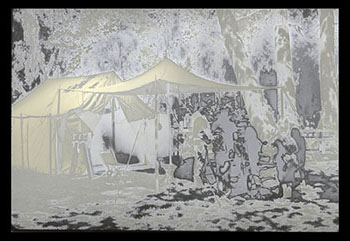 |
|||
|
|
|
Selective Reversal – by Harvey W. Yurow Ph.D.
This paper introduces a new approach to abstract diapositives – dichromate bleach re-reversal (DBR), which resembles permanganate bleach re-reversal, but relies on surface image instead of internal image desensitization. Further, rather than utilizing quantitative reversal, selective reversal is chosen, with the processing sequence being exposure, development to a negative, second exposure, bleach, clearing and second development to a positive. This pathway is notable because second exposure precedes bleaching and clearing. In addition, while results for PBR are fairly predictable when parameters are closely adhered to, those for DBR are somewhat problematic, yielding two distinct types of diapositives despite close control of conditions. History: Many reports have appeared in the literature since the initial paper by Namias in 1900, utilizing permanganate and quantitative reversal, for the conversion of a film negative to a positive for direct viewing. Since the report by Namias, permanganate and dichromate have vied for predominance in reversal processing (Stenger, Coenen, Verkinderen). However, dichromate took precedence because of problems with reproducibility in amateur motion picture processing (re-reversal) as first indicated by Capstaff in 1924, and as described by Ives, “Permanganate bleaches are difficult to control because they exert a complex influence on the re-exposure sensitivity”. However, with ecological concerns in the 1990's, dichromate bleach was replaced by permanganate in Kodak's reversal kits.
In the 1930's, especially with regard to sound track motion pictures, the selective method of reversal was recommended as giving higher contrast, because of the masking effect of the silver negative image on the second exposure, as well as by producing better sound reproduction (Gorisch, Lichte and Narath). The fact that the selective method was primarily reported in relatively unfamiliar German publications prior to and during the Second World War, contributed to the obscurity of this procedure, as did the cautionary statement of Mason that “Reversal processing involving a re -exposure must always be given after the bleaching stage because these bleaches (permanganate or dichromate) being oxidizing agents, would destroy the latent image formed by the re-exposure if bleaching were done after the re-exposure”. However, in partial (“flash”) bleaching (Falla), dichromate selectively desensitizes remaining silver bromide, but does not completely destroy the latent image.
Experimental: The film investigated in these studies was Kodak T-Max 100 in 35mm size. A recommended outdoor sunlit landscape exposure is 1/125 sec at f8, with a Wratten #25 red filter. However, for re-reversal effects, a one stop underexposure (1/125 sec at f11) sometimes gives more interesting results. A cloudless sky, which results in deeper shadows, is preferable. The light fogged leader section of the film roll is cut off before processing to lower negative silver and enhance re-reversal. For dissolving negative silver, one can either use the Kodak R-9 bleach, which contains a mixture of 9.5g of potassium dichromate and 11cc of concentrated sulfuric acid per liter, and has a variety of compounds including chromic and dichromic acids, or the author's comparable substitute formula of 8g of chromium trioxide (which hydrolyses to chromic acid in solution) and 25g of sodium bisulfate per liter. Clearing is provided by 2.5% sodium sulfite. First developer is Kodak D-19 with 5g/l of added potassium thiocyanate (Dietrich), and second developer is typical M-Q, such as Kodak D-97. In the directions below are given the processing instructions for selective reversal of Kodak T-Max 100. The author prefers 10 -12 exposure half rolls for ease of second exposure in a tray. Processing was in a Nikor single roll 35mm film tank with 250ml volumes of solution at a temperature of 20-22° C.
*Bleach concentration and contact time approximate those of Falla. Agitation is constant with torus (twist) tank inversion (Adams)
, with a sequence of 5 sec. fill, 25 sec. agitation, and 5 sec. empty. Single use for diluted bleach is made with distilled water. The equation for bleaching of silver image by acid-dichromate (Glafkides) is: 6Ag + K2Cr2O7 + 7 H2SO4 = 3Ag2SO4 + K2SO4 + Cr2(SO4)3 + 7H2O The carcinogenic properties of dichromates should be considered in any experimental work, and suitable precautions, such as gloves for handling, and adequate disposal, including reduction to trivalent chromium with sodium sulfite, should be taken.
As a consequence of desensitization from flash bleaching, slides of outdoor scenes often exhibited rather unusual appearances, frequently similar to those with permanganate bleach desensitization. Tree canopies and shadow areas under overhangs showed low densities, while dark contour lines surrounding various scene objects were very prominent. As found with permanganate re-reversal, the most suitable outdoor subjects include buildings, bridges, monuments and boats, with complex surfaces containing both sunlit and shadow areas (Yurow 2014). Also effective pictorially are detailed subjects such as potted plants, bric-a-brac, small tools, etc. in sunlight, clustered against a low reflectivity background in shadow, as often found in plant nurseries, or outdoor antique displays. The outlining black contour lines are an integral part of the overall surrealistic effect. As mentioned above, with dichromate bleach re-reversal, two distinct types of images are obtained. The more predictable form resembles permanganate bleach re-reversal with clear highlights, dark gray middle tones, and pale gray, low contrast, grainy shadows. The relatively elusive variation has yellow tinted highlights, dark middle tones, and low density shadows, with both examples exhibiting distinctive contour lines at borders. These two renditions will now considered from a theoretical viewpoint. Theory: Re-reversal, which leads to images with low shadow densities, dark contour lines, and novel semi-abstractions, is occasionally encountered in conventional B&W reversal procedures (Capstaff, Rahts, Verkinderen), and is favored by both first and second underexposures. Its theoretical basis results from differential desensitization by bleach of undeveloped silver bromide. With permanganate bleach re-reversal, internal image desensitization is involved (Yurow 2014), while with dichromate bleach re-reversal – the subject of this paper, surface image desensitization is responsible (Falla). During flash bleaching with dichromate, which involves rapid kinetics even at markedly reduced concentrations, the following mechanism appears to be reasonable in explaining the results produced:
Middle Tones: Significant negative silver density leads to preferential dichromate attack on it, rather than on sub-image surface specks on the accompanying silver bromide. In addition, silver ion thus formed slows further attack on the specks because of the Law of Mass Action. Consequently, desensitization is much less than that for the shadow regions, and a weaker degree of desensitization leads to higher final densities. Highlights: Here, because silver bromide has been essentially completely reduced to silver, any degree of desensitization is inconsequential to final results. As indicated above by Falla, “the desensitization effect of chromic acid solution is mainly due to adsorbed oxidizing anions, which act as traps for photoelectrons during exposure”, and may be an important mechanistic factor in the results here obtained. Because of absence of sulfite clearing before second exposure in the current work, dichromate ion residue after flash bleaching will be present in significant amounts in the shadow and middle-tone regions during second exposure. As another possible contributing factor to desensitization, the photochemical hardening effect of trivalent chromium on the emulsion gelatin may play some part (Wall), because dichromate tans the gelatin at the site of bleaching, as a consequence of the formation of chromium oxide as the reduction product (Haist). The attack of dichromate bleach on silver presents another mechanistic possibility. With regard to sub-image specks on the silver bromide, these come in a variety of sizes (Berg, Jaenicke), with at least four silver atoms in the speck being required for stability. Larger sub-image specks are more stable to attack by bleach, but as indicated by Mees, “ In the course of being completely oxidized, a latent image center must pass through the state of being a silver atom, which is unstable. If the disintegration of the silver atom into a silver ion and a mobile electron proceeds more rapidly than the atom can be oxidized by the bleach, mobile electrons are released into the conductance band whence they can be collected at a suitable center and convert an undevelopable latent subimage into a developable one”.
While the Albert Effect, which also involves chromic acid attack on surface latent image (Mees), bears a superficial resemblance to the present work, the strong initial exposure required to produce a desensitizing internal latent image sufficient for reversal is much greater than that for any instantaneous camera exposures customarily applied . However, T-Max 100, with its unusual silver halide crystal structure, may enhance internal image formation. In addition to the expected results, a distinctive second variation of DBR sometimes pops up, which is distinguished by delicate yellow tones in highlight areas of the image. The author suspects that this phenomenon is connected with the varying ratio of flash bleach solution dichromate concentration to the amount and distribution of negative silver (difficult to control) on the film following first exposure, as well as the lack of equilibrium in the rapid flash bleach step. If this supposition is valid, then occurrence of this variation presents a more complicated picture, and is at present unpredictable, which adds to its novelty. This phase of the work awaits investigation by other photographic experimenters. However, of possible relevance to the yellow highlight color formation, it must be mentioned that a warm stain, which is sometimes present in the highlights for normal reversal procedures, has been reported in several papers (Ives, Miller, Zuidema), and is due to a chromium and silver material, which can persist throughout the entire reversal process. Its production is favored by fine grain emulsions, because the relatively great surface of small grains result in rapid reaction with the bleaching bath. Its occurrence is also promoted by increased acid concentration in the bleach, higher pH of the bleach solution, and in those regions where the silver density of the first development was greatest, such as the fogged end of a film strip. In addition, this stain-forming substance is considerably less sensitive to re-exposure than is the residual positive silver halide.
It is interesting to compare abstract or semi-abstract photographic results with works by various painters. Consequently, it appears to the author that some of the high key examples are suggestive of works of the surrealist painter Yves Tanguy with regard to his “alien landscapes populated with various abstract shapes, sometimes angular and sharp as shards of glass, sometimes with an intriguingly organic shape to them” (Wikipedia), accompanied by characteristic dark contour lines against formless backgrounds (Swinglehurst). Specific examples of this type by Tanguy on the Internet are: “Multiplication of the Arcs”, “The Sensitive Layer”,“The Ribbon of Excess”, and “Saltimbanques”.
References
|
||||||||||||||||||||||||||||||||||||||||||||||||||||||||||||||||||||||||||||||||||||||||||||||||||||||||||||||||||||||||||||||
|
|
|
|
|
